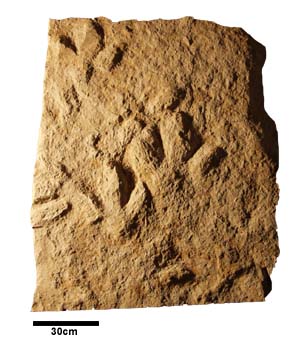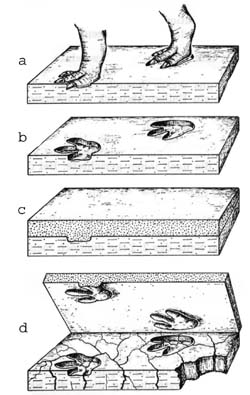Dinosaur tracks
 The 148×120 cm large slab with dinosaur footprints comes from the Obernkirchen Sandstone (Lower Cretaceous) of Obernkirchen, west of Hannover. It has been produced most probably by an Iguanodon. This dinosaur lived about 135 million years ago, close to the boundary between the Jurassic and Cretaceous periods. The tracks show footprints of dinosaurs walking in at least two directions, the length of footprints is between 20 and 40 cm. The trace fossils have been produced by at least four different, not fully grown specimens and confirm that this dinosaur genus was common in the Early Cretaceous of Northern Germany and that at least the younger specimens walked bipedally. Dinosaur tracks like the Bremen rock slab tell us much more about the life habits and locomotion of dinosaurs than we would know from studying their skeletons only. The detailed investigation of tracks has changed our view of dinosaurs significantly for the past decades. In recent days we know that they are not the clumsy giants headed for extinction, but rather a dynamic group of animals with a big phylogenetic success. The Bremen rock slab makes it likely that Iguanodon was a dinosaur that lived in herds, to gain protection from predatory dinosaurs (theropods). Additional facts about its life style are shown by the skeletons of Iguanodon that reveal a specialised dentition suggesting a herbivorous diet.
The 148×120 cm large slab with dinosaur footprints comes from the Obernkirchen Sandstone (Lower Cretaceous) of Obernkirchen, west of Hannover. It has been produced most probably by an Iguanodon. This dinosaur lived about 135 million years ago, close to the boundary between the Jurassic and Cretaceous periods. The tracks show footprints of dinosaurs walking in at least two directions, the length of footprints is between 20 and 40 cm. The trace fossils have been produced by at least four different, not fully grown specimens and confirm that this dinosaur genus was common in the Early Cretaceous of Northern Germany and that at least the younger specimens walked bipedally. Dinosaur tracks like the Bremen rock slab tell us much more about the life habits and locomotion of dinosaurs than we would know from studying their skeletons only. The detailed investigation of tracks has changed our view of dinosaurs significantly for the past decades. In recent days we know that they are not the clumsy giants headed for extinction, but rather a dynamic group of animals with a big phylogenetic success. The Bremen rock slab makes it likely that Iguanodon was a dinosaur that lived in herds, to gain protection from predatory dinosaurs (theropods). Additional facts about its life style are shown by the skeletons of Iguanodon that reveal a specialised dentition suggesting a herbivorous diet.
Origin of tracks in the Obernkrichen Sandstone

The Obernkirchen Sandstone of the Bückeberg Formation is a part of the Berriasian stage of the Lower Cretaceous. The track slab comes from the active quarry of the quarry estate of the company Obernkirchen Sandstone quarries ltd. at the Schauenstein near Obernkirchen, east of Bückeburg in Lower Saxony and has been collected during the recessing of the quarry in Sepetember 2002 (Lehmann 2003). The tracks are raised from the surface of the rock slab. This is the key question about how the Obernkirchen tracks were preserved. The rock slab that is on display nowadays was originally the bottom side. Primarily the dinosaur feet stepped into the soft and placable ground that was covered at the Obernkirchen site by shallow water and was even waterless in some cases. The material that gave way to the load of the dinosaurs was fine sand, silt or clay. The casts that were formed were filled with sand material in the shallow water. During diagenesis the sand turned into sandstone, but the finely grained beds are not consolidated to date. The latter are being destroyed by the quarrying of the sandstone beds. This is the reason why the fillings of dinosaur imprints are preserved at the bottom sites of the sandstone only under regular conditions. The unclear imprint of the pad indicates a fast walk of the animals producing the track, following Dollo (1906). A slow locomotion produces a much clearer outline of the pad and back part of the footprint and a pause causes an unclear outline of the front part of the footprint producing four round-oval traces.
References:
- Dollo, L. (1906): Les allures des Iguanodons d’après les empreintes des pieds et de la queue. – Bulletin Scientifique France-Belgique 40(5e série, vol. 4): 1-12.
- Lehmann , U. (1978): Eine Platte mit Fährten von Iguanodon aus dem Obernkirchener Sandstein (Wealden). – Mitteilungen aus dem Geologisch-Paläontologischen Institut der Universität Hamburg 48: 101-114.
- Lehmann , J. (2003): Dinosaurierfährten aus dem Obernkirchen Sandstein (Unterkreide, Berriasium) in der Geowissenschaftlichen Sammlung der Universität Bremen. – Abhandlungen herausgegeben vom Naturwissenschaftlichen Verein zu Bremen.
- Lehmann , J. (2006): Dinosaurier – Spuren einer vergangenen Welt. Münchehagen, der Bremer Stein und die Saurierfährten. Bremen . – Haus der Wissenschaft 3: 91 p.; Bremen .
- Lehmann, J., Krogmann, M., Richter, U. & Broschinski, A. (2006): Neue Dinosaurierfährten vom Rang eines Naturdenkmals in den Sandsteinen der Bückeberg Formation (Unterkreide, Berriasium) von Münchehagen (Niedersachsen). – Abhandlungen herausgegeben vom Naturwissenschaftlichen Verein zu Bremen 46: 27-38.
- Richter, U., Richter, A., Lehmann, J. (2007): Fährtensucher auf der Dinospur in den Rehburger Bergen. – Fossilien 24: 11-20.
